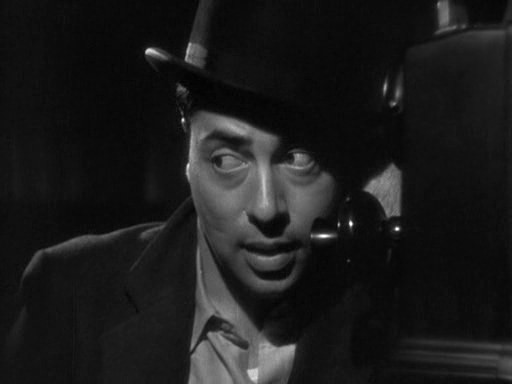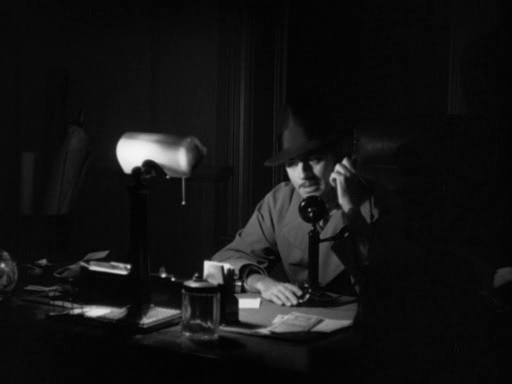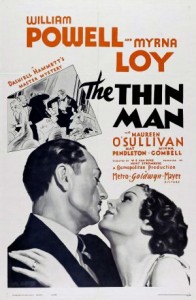|
Genres, Themes, Actors, and Directors:
- Cesar Romero Films
- Comedy
- Detectives and Private Eyes
- Maureen O’Sullivan Films
- Murder Mystery
- Myrna Loy Films
- William Powell Films
- W.S. Van Dyke Films
Response to Peary’s Review:
Peary notes that this “wildly successful blend of… murder mystery and… screwball comedy” (adapted from a novel by Dashiell Hammett) possesses “delectable performances by William Powell and Myrna Loy as Nick and Nora Charles” — the most ridiculously happy married couple ever to grace the silver screen. Indeed, while it’s nominally a detective story, what people remember most about The Thin Man is the central relationship between Powell and Loy, whose chemistry together is pitch perfect. They’re a rare “sexy married couple… who enjoy each other’s company, sense of humor, [and] conversation”, and — given that they’re independently wealthy, and don’t yet have any children — are able to devote their lives to simply having fun. As Peary notes, “if you don’t get upset by Nick’s constant imbibing” (the amount of liquor poured and drunk in this post-Prohibition-era film is truly astonishing), you’ll enjoy “watching them and their dog-child”, Asta — whose breed (wire-haired terrier) immediately became all the rage in America.
Much of the credit for the success of The Thin Man belongs to its director, W.S. Van Dyke (“One-Take Woody”), who — shooting in just 12 days and working with Albert Hackett and Frances Goodrich’s “breezy adaptation” of Hammett’s novel — managed to infuse the film with “an improvisational feel, with characters moving freely in and out of the frame”. Equally noteworthy is James Wong Howe’s atmospheric cinematography (see stills below), as well as a fine supporting cast — all of whom end up as suspects. Indeed, while the murder mystery here could almost be considered a MacGuffin (as argued by Roger Ebert in his “Great Movies” overview of the film), it’s actually a reasonably enjoyable whodunit which will certainly keep you guessing. Followed by five sequels and a television series, and selected for inclusion in the National Film Registry at the Library of Congress in 1997. Spoofed in Neil Simon’s Murder By Death (1976), with David Niven and Maggie Smith as Dick and Dora Charleston.
Redeeming Qualities and Moments:
- William Powell as Nick Charles (nominated by Peary as Best Actor of the Year in his Alternate Oscars)

- Myrna Loy as Nora Charles

- Fine supporting performances

- James Wong Howe’s cinematography

- Albert Hackett and Frances Goodrich’s extremely witty, fast-paced, entertaining script
Must See?
Yes, as a genuine classic. Interestingly, while it was nominated for an Academy Award as Best Picture of the Year (as well as Best Director, Best Adapted Screenplay, and Best Actor for Powell), Peary doesn’t include it as a contender in his own Alternate Oscars book.
Categories
(Listed in 1001 Movies You Must See Before You Die)
Links:
|





One thought on “Thin Man, The (1934)”
A no-brainer must.
~and a perfectly delightful romp, if one can say that about a murder mystery. Here actually one can. That’s a surprising plus about ‘TTM’; while the story’s dramatic aspect is realized appropriately, director Van Dyke is much more in tune with emphasizing the film as entertainment. The parallel lines of fun and brain-tease often intermingle seamlessly. I would agree that Van Dyke does get a good deal of the credit – but Hackett and Goodrich’s script is not only an “extremely witty, fast-paced” one, it is a terrific example of economic construction. There is a whole lot going on – in various directions – in the early part of the film. Just as we start wondering where and when the intriguing elements will meet at a cross-road, we meet one. At that point, a clever series of wipe scenes (each consisting of two or three sentences) tumbles at us like a snowball downhill, fusing the disparate elements. (I find that section thrilling.) The wild ride continues from there.
Powell and Loy are, of course, tops and basically run this show. They are, indeed, “the most ridiculously happy married couple”. If this movie serves no other purpose, it’s a great one for studying how to be with your significant other. And, no, you don’t have to be a borderline-alkie; that’s not what I mean. When it comes to booze, nobody has the constitutions these two have.
I’ve seen this movie every so often (it’s a ton of fun returning to) – and, perhaps not so strangely, it’s one I can never seem to remember the ending of when I start watching it. (Well, so far.) That could very well be due to the wonderfully large number of plausible suspects. This is one tangled tale, folks. In fact, when Powell finally does detail the steps for us in the penultimate scene, be prepared for a rather verbose blow-by-blow of what went on and who did what. Not that the bulk of it needs to be straight in one’s mind. At least I know who did it. (Well, at the moment, I do.)
A fave sequence: the unexpected (except that you know now) inclusion of the snappy number ‘Blow That Horn’ performed in a club.
btw: Peary skips over the immediate sequel, ‘After The Thin Man’, and goes on to include ‘Another Thin Man’ in his book. Wondering about a possible reason for that (since ‘ATTM’ seems to be held in high regard; many think it’s better than the original), I gave it another look. I think it’s a very solid sequel overall, though I wouldn’t go so far as saying it beats part one. It’s much more leisurely paced – and perhaps a little longer than it needs to be. Powell and Loy are again in top form. Not a must (unless you’re really smitten with Powell and Loy), but a worthy-enough sequel.